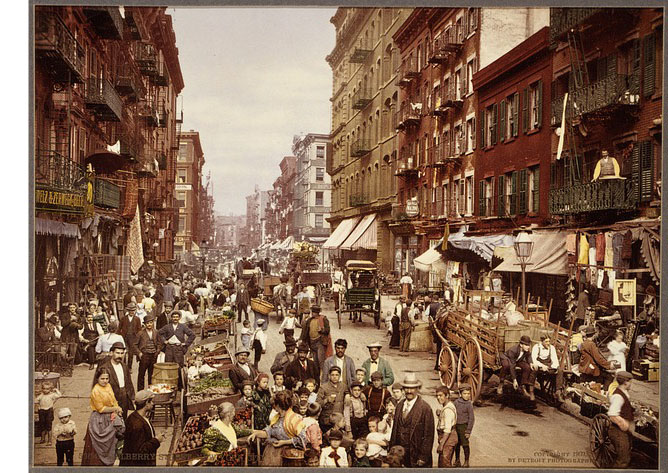The Lasting Impact of Italian Immigration on American Culture
A DEEPER LOOK INTO ITALIAN AMERICAN CULTURE WITH EDUCATIONAL RESOURCES
In the late 1800s, Italian natives began to seek a new life and citizenship in America. By 1915, it’s estimated that approximately 13 million people immigrated from Italy to the United States. This created a whole new subculture, and many of these people took up residence in New York City. Over time, these Italian immigrants began to form their own unique communities, and each one centered culturally around the town from which they came. The Little Italy neighborhood sprang up, consisting of about 30 city blocks on the Lower East Side of New York City. It was here that these new Italian immigrants started a new life and learned a new language to integrate themselves into American life while sharing their native culture.
By 1910, New York’s Little Italy was populated with around 10,000 Italians. Each subsection of the neighborhood represented different towns from the residents’ native land, but together, they created a mixture of foods, dialects, and cultures that came together to form one of the country’s most well-known neighborhoods. Some of the areas of Italy that people emigrated from included the country’s poorest regions, including Sicily, Calabria, Abruzzo, and Campania. When they arrived in America, they took on a range of jobs, including working for industrial production companies like steel mills and coal mines and in the field of masonry.

Their work ethic and desire to improve helped Italian culture become an integral part of the fabric of American life.
- How America Became Italian
- Little Italy: Evolution
- History of Italian Immigration
- Italians: The Great Arrival
- Digital History: Italian Immigration
- Italian Immigration and Settlement
As waves of Italians came through Ellis Island, they brought their love of food with them. Today, Italian food is undoubtedly one of the most popular of all ethnic foods. This delicious cuisine has changed the way people eat today: Everything from pizza to meatballs to marinara sauce can be credited to the Italian way of life. One of the earliest meals that Italians introduced was chicken tetrazzini, which is still a popular dish today. Items like Louisiana’s popular muffuletta sandwich can be traced back to rolls baked in Sicily that were given to workers. And Philadelphia’s famous cheesesteak sandwich also hails from Italy.
- A Brief History of Italian Food in America
- How Italian Cuisine Became as American as Apple Pie
- Italian history resources
- A History of Sicilian Cuisine
Aside from language and food, Italians brought with them a rich history and understanding of art and culture. From famous sculptors and painters to opera singers, the country already had its fair share of talent before people began to immigrate to America. With the advent of the industrial age and the popularity of entertainment growing, many Italians shared their talent with others. An Italian by the name of Frank Capra went on to direct more than 20 feature films, including the Christmas classic It’s a Wonderful Life. Other famous Italian-American filmmakers include Francis Ford Coppola and Martin Scorsese.
The impact of Italian immigrants has been felt far and wide in our culture. In addition to filmmakers, actors like Sylvester Stallone, James Gandolfini, and Marisa Tomei have made an impact on the big and small screens. Singers like Liza Minelli, Ariana Grande, and Tony Bennett have all earned fame in the world of music. The impact of Italy and its people is seen, heard, and felt far and wide in every form of media.
- Italian-Americans
- The Godfather Effect
- Made in Hollywood: Italian Stereotypes in the Movies (PDF)
- It’s a Wonderful (Italian-American) Life
Sports like soccer, car racing, and even skiing are all popular activities that have long been revered in Italy. Soccer’s popularity has grown worldwide, and today, there are millions of fans in America, largely due to the influence of Italian immigrants. And many famous athletes have had Italian roots, including legendary baseball player Joe DiMaggio, who has often been hailed as one of the greatest players of all time. Other famous Italian Americans include Tommy Lasorda, Yogi Berra, and Joe Torre, former manager of the New York Yankees. Famed Olympian Mary Lou Retton is also of Italian descent. From boxing and football to golfing and figure-skating, Italians have long played an important role in American sports.
- Rocky Marciano
- Joe DiMaggio
- National Italian American Sports Hall of Fame
- Italian-American Boxing Triumphs: Rocky Marciano
This page was last updated with help of Marco Permunian
Additional Resources:
- Italian dual citizenship South Africa
- Italian dual citizenship UK
- Italian citizenship by marriage
- Italian citizenship 1948 case
- How to get Italian citizenship through great grandparents
- Italian dual citizenship Canada
- How do I become an Italian citizen
- Italian dual citizenship
- Italian citizenship benefits
- Requirements for Italian citizenship
- Italian dual citizenship Brazil, Argentina and South America
- Italian citizenship through descent
- Italian dual citizenship Australia
- Renew Italian passport


